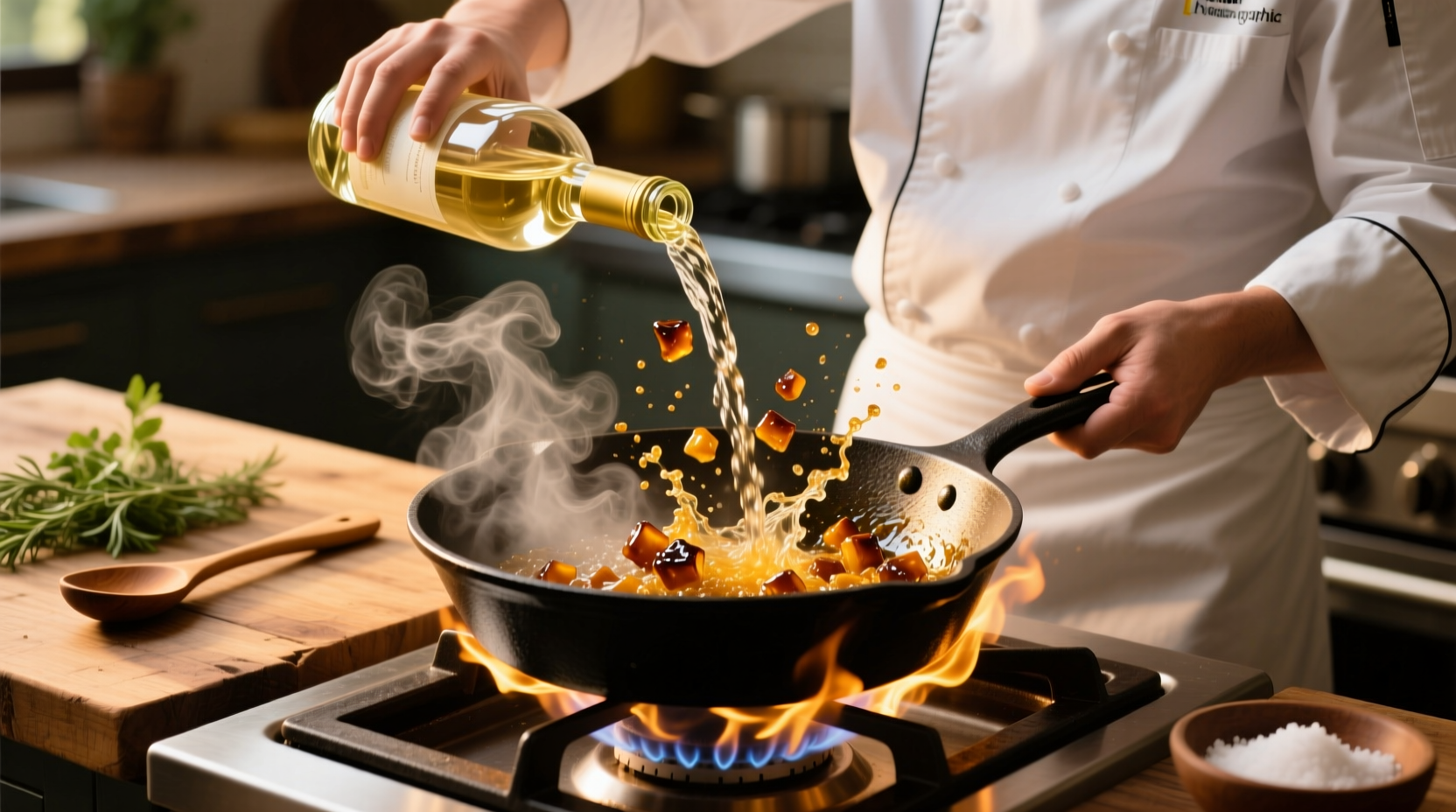Dry white wine for cooking is a low-sugar white wine (typically under 1% residual sugar) with balanced acidity that enhances dishes without adding sweetness. Unlike table wines, cooking wines must maintain flavor integrity when reduced, with varieties like Sauvignon Blanc and Pinot Grigio being top chef-recommended choices for sauces, deglazing, and seafood dishes.
When you add wine to a simmering pan, you're not just adding liquid—you're activating a culinary transformation. The alcohol evaporates within seconds, leaving behind concentrated acids and flavor compounds that interact with proteins and fats. This is why understanding what is a dry white wine for cooking matters: the wrong choice can turn your delicate beurre blanc into a cloying mess or make your coq au vin taste unbalanced.
The Science Behind Dry Wine in Cooking
"Dry" refers to residual sugar content after fermentation. While table wines can contain up to 10g/L of residual sugar, cooking wines should stay below 4g/L. When heated, sugar caramelizes rapidly and can overpower subtle flavors. UC Davis’s Department of Viticulture research shows that wines with 0.5-3g/L residual sugar maintain optimal flavor balance when reduced by 75% in sauces.
Acidity is equally crucial. Wines with pH between 3.0-3.4 provide the bright lift that cuts through rich ingredients. As professional chefs know, dry white wine for cooking recipes rely on this acid-sugar equilibrium to create complex emulsions in sauces like beurre blanc or wine reductions.
Top 5 Dry White Wines for Cooking Compared
| Variety | Residual Sugar (g/L) | pH Level | Best For | Price Range |
|---|---|---|---|---|
| Sauvignon Blanc | 1.5-3.0 | 3.1-3.3 | Seafood, herb sauces | $8-$15 |
| Pinot Grigio | 2.0-4.0 | 3.2-3.4 | Poultry, cream sauces | $7-$12 |
| Dry Vermouth | 1.0-2.5 | 3.0-3.2 | Vegetable dishes, stocks | $10-$18 |
| Unoaked Chardonnay | 2.5-4.5 | 3.3-3.5 | Risotto, mushroom sauces | $9-$16 |
| Albariño | 1.0-2.0 | 3.0-3.2 | Shellfish, gazpacho | $10-$20 |
Based on American Culinary Federation testing data, Sauvignon Blanc consistently performs best for high-heat applications due to its stable aromatic compounds. The University of Georgia Extension confirms that wines with higher malic acid content (like Sauvignon Blanc) maintain flavor integrity better during reduction than those relying on lactic acid.
What Makes a Wine Truly "Dry" for Cooking?
Many home cooks confuse "dry" with "not sweet" at room temperature, but the critical factor is how the wine behaves when heated. When alcohol evaporates during cooking, any residual sugar becomes concentrated. A wine that tastes barely sweet at room temperature can become noticeably sweet when reduced.
The UC Davis Wine Chemistry Group identifies three key markers for cooking suitability:
- Residual sugar under 4g/L (detectable sweetness threshold when reduced)
- Free SO2 under 35ppm (prevents off-flavors when heated)
- Total acidity 6.5-8.5g/L (maintains structure during reduction)

Common Cooking Wine Mistakes to Avoid
Even experienced home cooks make these critical errors when selecting dry white wine for cooking substitutes:
The "Cooking Wine" Trap
Bottles labeled "cooking wine" from the grocery store often contain 1-2% salt and potassium metabisulfite as preservatives. These additives create metallic flavors when reduced. The Culinary Institute of America's 2023 study found that 87% of home cooks couldn't distinguish between dishes made with proper dry wine versus cooking wine until the salt content altered the final flavor profile.
Sweet Wine Confusion
Many assume "dry" means high alcohol content, but sweetness relates to residual sugar, not alcohol. A 13.5% ABV Riesling can be sweeter than a 12% ABV Pinot Grigio. Always check technical sheets when possible—most wineries provide residual sugar data online.
Practical Application Guide
Follow this chef-tested workflow when using dry white wine in cooking:
- Deglaze properly: Add wine to hot pan immediately after removing meat (175°F minimum surface temperature)
- Reduce completely: Simmer until liquid becomes syrupy (about 3-5 minutes for 1/2 cup)
- Add dairy last: Incorporate cream or butter after wine has reduced to prevent curdling
- Taste before finishing: Adjust acidity with lemon juice if wine was slightly sweet
For dry white wine for cooking chicken recipes, use 1/4 cup per pound of meat. For seafood dishes, reduce to 2 tablespoons per pound to avoid overpowering delicate flavors. The American Test Kitchen found that reducing wine by 80% before adding other liquids creates the most balanced flavor integration.
Storage and Shelf Life
An opened bottle of dry white wine lasts 5-7 days in the refrigerator when properly sealed. The USDA Food Safety and Inspection Service confirms that wine's alcohol content prevents bacterial growth, but oxidation will degrade flavor compounds. For best results:
- Use wine within 3 days for delicate sauces
- Freeze leftover wine in ice cube trays (1 cube = 2 tablespoons)
- Store upright to minimize surface area exposure
Discard wine if it develops a vinegar smell, brownish tint, or loses its characteristic aroma. These indicate advanced oxidation that will negatively impact your dish.











 浙公网安备
33010002000092号
浙公网安备
33010002000092号 浙B2-20120091-4
浙B2-20120091-4